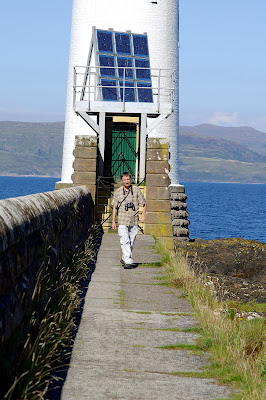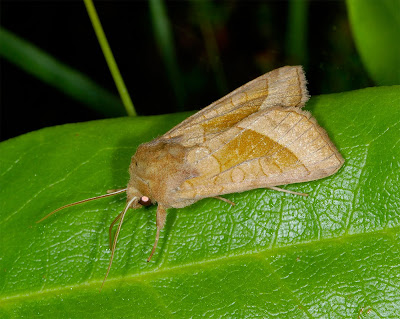Mull is a large island (over 300 square miles), notable for its extensive oak woods and its offshore reefs which support a rich diversity of marine species. It's a hotspot for cetaceans (particularly Minke Whales) and is the best place in the UK to see White-tailed Eagles.
Transport involved a train from Glasgow to Oban, a ferry from Oban to Mull (Craignure) and a bus from the ferry terminal to Tobermory - where we stayed at the Tobermory Youth Hostel (SYHA).
Herring Gull (Larus argentatus)
As we boarded the ferry at Oban, we saw a sharp-winged flock of Common Terns (Sterna hirundo).
In the dazzling sunshine, the ocean seemed an intense tropical blue, Oban's forested shores were emerald-green and the surrounding islets exotic archipeligos in shades of aquamarine.
Oban
We dropped off our rucksacks at the youth hostel and took an evening stroll along the coastal path from the northern end of Tobermory to the lighthouse at Rubha nan Gall.
Isle of Kerrera to left
Isle of Lismore lighthouse (built in 1833)
We dropped off our rucksacks at the youth hostel and took an evening stroll along the coastal path from the northern end of Tobermory to the lighthouse at Rubha nan Gall.
This steep and winding track passes through cliffside deciduous woodland, where Hazel, Tutsan and Burnet Roses grow by the side of the path and eventually opens out onto rocky shore and rough grassland with swathes of striking Ox-eye Daisies, Knapweed and Hemp Agrimony.
Hemp Agrimony (Eupatoria cannabinum)
Ox-eye Daisy (Leucanthemum vulgare)
Ox-eye Daisy (Leucanthemum vulgare)
Ox-eye Daisy (Leucanthemum vulgare)
The Ox-eye daisy has pungent, edible leaves which can be eaten raw or cooked (the unopened flower buds are good candidates for pickling).
Scotch Argus butterflies (Erebia aethiops) fluttered through the grasses around Rubha nan Gall lighthouse - a brilliant white-washed, blue solar panelled pillar against the blue skies.
Gannets crash-dived the seas and Rock Pipits flitted about the shore, peering at us from yellow lichen encrusted rocks.
Rubha nan Gall lighthouse (built in 1857)
Gannet (Morus bassanus)
The Gannet (Morus bassanus) is the only member of the Sulidae family (Gannets & Boobies) to be found in Europe and the UK holds more than 50% of the world breeding population, with all birds spread amongst only 21 colonies in Britain & Ireland.
When hunting for fish, these huge birds dive from heights of up to 30 metres to depths of up to 34 metres (mean diving depth is thought to be around 20 metres). Morphological adaptations to this lifestyle include a lack of external nostrils (Gannets breathe through their mouths), the presence of 'cushioning' subcutaneous air sacs and the forward positioning of the eyes to enable sharp binocular vision.
The lighthouse fence - a row of delapidated shamrocks
Rock Pipit (Anthus petrosus)
Rock Pipit (Anthus petrosus)
Rock Pipit (Anthus petrosus)
Sea Buckthorn (Hippophae rhamnoides)
On our walk back to the hostel, an adorably fat vole ran along the path ahead of us, stopping frequently to look behind and check if we were gaining on it!
Nightwalk:
We set out from Tobermory in the late evening and walked to the nearby Aros Park (South of Tobermory) - an area of mostly non-native woodland, tutsan and large Rhododendron bushes.
I released a Rosy Rustic which I had found earlier on a windowsill in Tobermory and the moth began feeding on the aromatic, sticky leaves of Rhododendron.
Rosy Rustic (Hydraecia micacea)
Rosy Rustic (Hydraecia micacea)
One of the woodland tracks led us to a rocky pier with stacked lobster pots and a nearby house/barn from which emanated the ultrasonic click-twittering of many bats.
We waited, in the fading light, for the bats to emerge (accumulating vast clouds of midges in the process) and within a few minutes they did - individuals shooting out of a miniscule hole between the rafters every few seconds, while the bats inside chirped ever louder. The crescendo died down as the remaining bats (probably pipistrelles) exited the roost and vanished into the dark woods.
Distant flocks of Redpolls could be heard but not seen, in the encroaching dusk.
On our return to the hostel in pitch blackness, we were stopped in our tracks by a strange noise - a loud, fierce, cat-like hissing - coming from the branches of an oak tree just off the path. As we stood listening, we could determine that the sound came from 2 sources...but were they birds or mammals?
Shining an LED headlight in their direction did not reveal reflected eyeshine. Although initially mystified as to the identity of the furious hissers, we soon realized that it was a pair of juvenile Barn Owls!
Leaving the noisy owlets behind, we continued our nocturnal journey. Rustling creatures in the undergrowth were revealed, by torchlight, to be enormous orange-eyed Common Toads lumbering about.
























Lovely pictures. I loved the gannet picture the most. It reminds me of the day when I had been to see sir show.
ReplyDelete